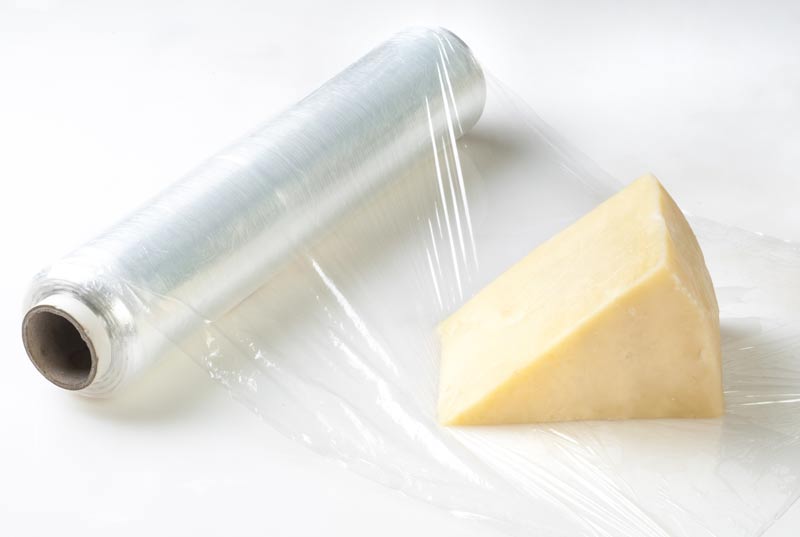In the 1960s, I used to help my mother in the kitchen and learned how to cook. I used Saran Wrap to cover plates and bowls, and I noticed that this material was sort of magical. It stuck to what I wanted it to stick to and wasn’t much inclined to stick to itself. What is this sorcery? You could pull it back to access something in a bowl, then seal it back up again. I was fascinated because it seemed like it was intelligent. I had studied some chemistry but not yet enough to guess the cause for this marvelous behavior.

So what was this wonderful material I was working with? In 1933 a chemist at Dow Chemical was trying to develop a new dry cleaning solvent. He noticed that certain beakers and glassware were hard to clean. They had a residue that was hard to scrub off. Investigation revealed a new substance, a new polymer that was named polyvinylidene chloride or PVDC.
It was found that, among other things, PVDC made a tough and durable clear coating. During World War 2, virtually every U.S. aircraft was coated with PVDC to help protect it from the elements. At the end of the war, hundreds of companies in the U.S. got busy looking for commercial applications for the countless marvelous things they had developed for the war effort. Somebody at Dow realized that PVDC would make an excellent food wrap. And excellent it was, as you will see later. Production methods for forming PVDC into a very-thin film were developed. The CEO of Dow decided to name it after his wife and daughter, Sarah and Ann: Saran.
The product was introduced in 1949 and was an almost overnight success. This is the stuff I was using in the 1960s. Towards the end of the 1960s, Dow’s patents expired and other companies began producing PVDC food wrap, like Glad Wrap. They were all just copies of Saran Wrap.
From the 1990s forward, I didn’t use much plastic food wrap until I began to work in a restaurant in 2012. There, I used plastic food wrap all the time and immediately noticed that it behaved differently from what I remembered. Sure, it worked, but it frequently refused to stick to some things and it was eager to stick to itself. This is not what I remembered. After opening and closing a covered bowl, the plastic wrap would become wrinkly and refused to stick to anything. I covered a mixing bowl full of diced onions with this plastic wrap and placed it in the cooler. Soon, the cooler smelled strongly of onions. What? That’s not supposed to happen. What is this stuff? Maybe some kind of cheap imitation of Saran Wrap?
Time passed, I finally did some digging on the Internet, and immediately found the answer. Through the 1990s, chlorinated polymers like PVDC became an increasing environmental concern. In 2004, all the makers of PVDC plastic wrap switched to ordinary low-density polyethylene (LDPE). Polyethylene is cheap and easy to make into a thin film. But there are problems. Big problems.
First of all, polyethylene is a low-friction, non-stick kind of polymer. This is why milk bottles are made from it. Polyethylene film doesn’t stick to anything, nor itself. Today’s polyethylene plastic food wrap is coated with a moisture-activated adhesive to make it “cling”. At best it clings to certain things but not others, and it eagerly sticks to itself, making it hard to work with.
Secondly, the adhesive quickly wears out so opening and reclosing a bowl covered with modern plastic wrap is something you might be able to do once but not repeatedly, like you can with PVDC film.
Thirdly, polyethylene film is around 3,000 to 4,000 times more permeable than PVDC film. Oxygen is the main culprit that causes food spoilage. For every molecule of oxygen that a given area of PVDC film lets through, polyethylene film lets through 3,000. The consequences of this are obvious. It also explains the experience I had with onions stinking up the cooler. That wouldn’t have happened with PVDC film. In fact, certain meats are still packed with PVDC film because polyethylene film can’t do the job.
The bottom line for me is I was pleased to discover that my memories from the 1960s were pretty accurate. However, I was not pleased to discover that the plastic film I use today is inferior in terms of performance and user friendliness, and there’s no way to fix it.
Today’s plastic wrap looks like classic Saran Wrap, but it ain’t. It’s not even close.




Recent Comments